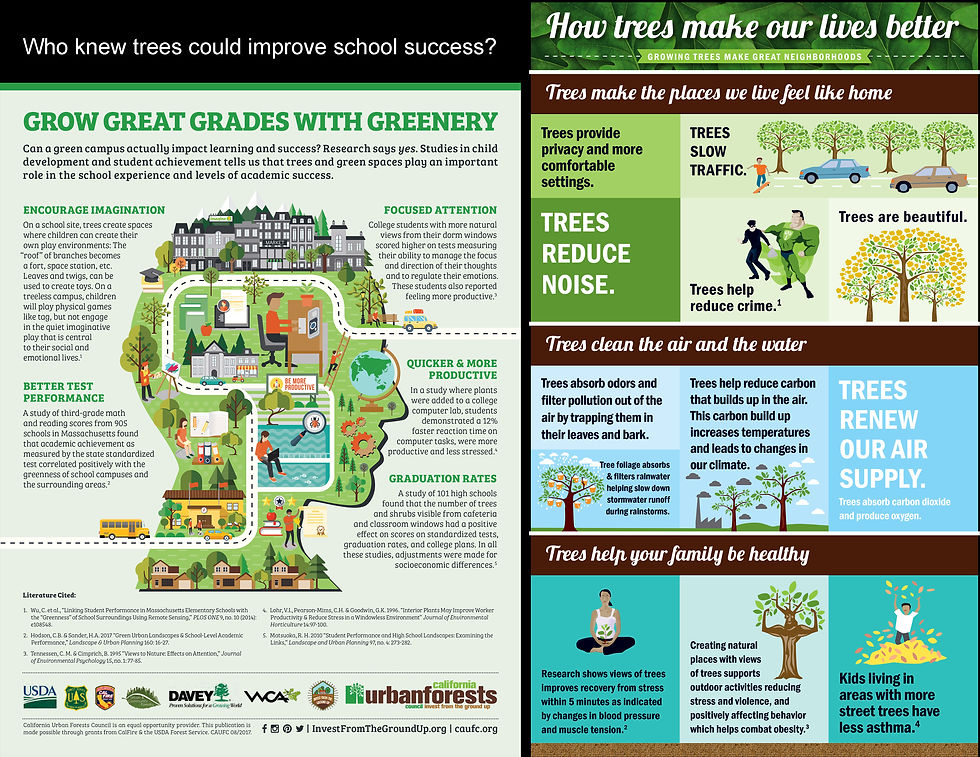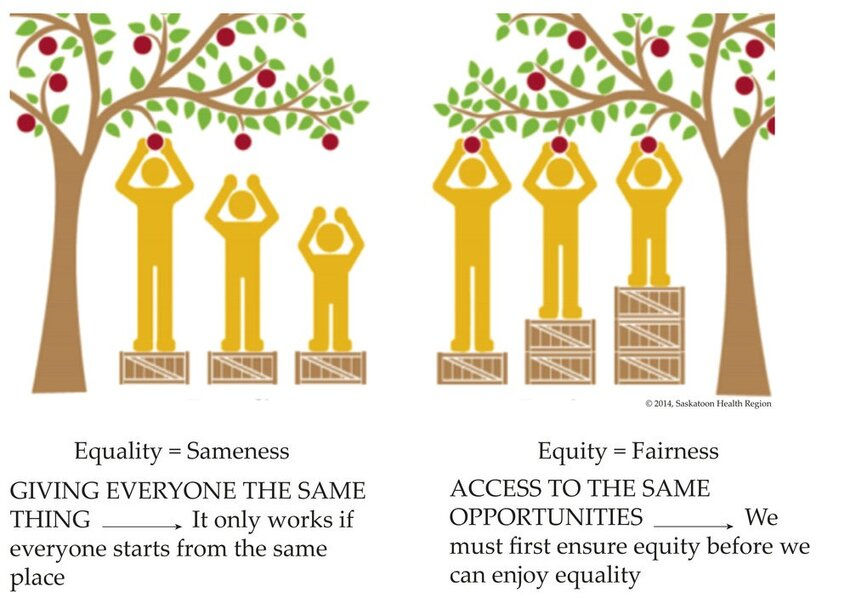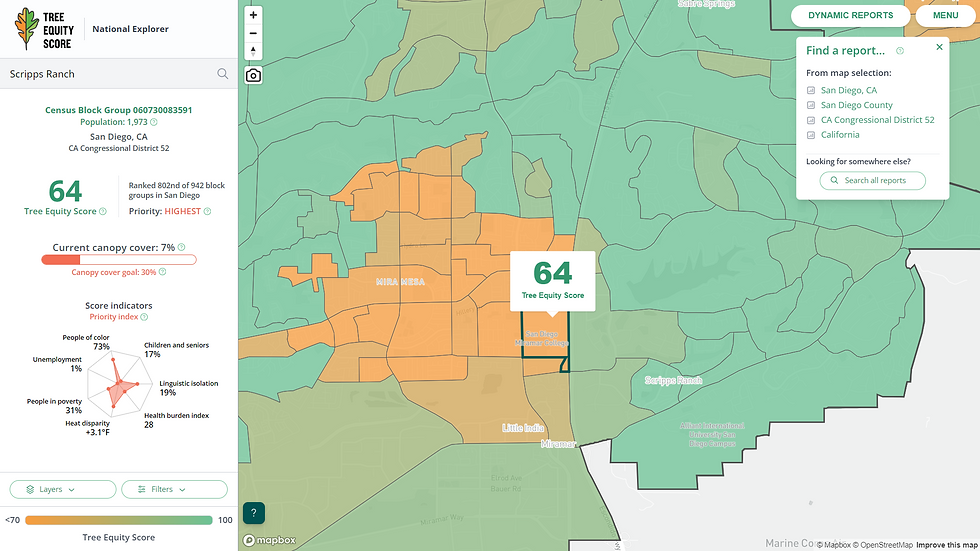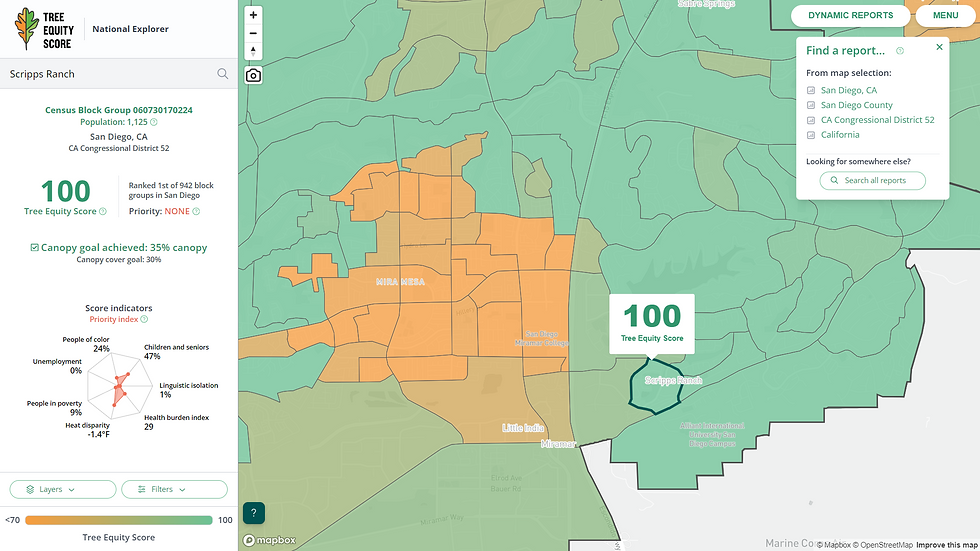By Robin Y. Rivet, for Let’s Talk Plants! October 2024.

Does Your Neighborhood Have Tree Equity?
Is “Tree Equity” just another political slogan? Absolutely not. And how is “equity” different than “equality” - and should it matter to you? For one, many jobs are created to obtain tree equity. Our urban forests are truly non-partisan assets, and whether they realize it - or not, every human being living in a neighborhood stands to benefit in some way from their powerful presence. Unfortunately, my experience suggests that until urban trees “go missing” at a park, community or shopping center, an elementary school, on a street where you walk - or even in one’s own yard; most citizens don’t pay enough attention - until they’re vanishing. Worse, it takes about a decade to replace a large “carbon-sucking, oxygen-exhaling, pollution-absorbing, stormwater-drinking, free outdoor air-conditioning system” – otherwise known as an urban “tree”. 😊

“Equality” frequently means allocating equal dollars of government budgets proportionately to everyone - typically based on population. But what if my neighborhood needs 200 additional trees to provide adequate shade along pedestrian or transit corridors, but your neighborhood is already shady, with only one dead tree that needs replacing? Did they receive equal budgets? There are tree distribution disparities in most all urban regions, and that’s where “equity” comes in. It’s a subtle distinction, but it’s incredibly vital. Every city in America has pockets of vulnerable human populations, but climate impacts are not paying attention to man-made boundaries, so inequities persist.

Thanks to American Forests, “tree equity scores” have been established for all major cities and numerous neighborhoods across the United States. Currently, this mapping includes about 80% of America’s population. In our large metropolitan area of San Diego County, most census tracts have already been evaluated, and each was given a score relative to goals for that region. Make no mistake, it is a real and measurable science-based algorithm that looks at how much tree canopy and related green infrastructure overlays urban land, and how that correlates to education, race, employment, income, heat indexes, public health, and other census variables.
Check out your community census tract here. The fact is, creating tree equity hasn’t been working very well for quite some time. Some neighborhoods have far fewer trees because the housing plots were originally smaller, front yards may have been usurped to widen older streets or provide additional parking – and trees were felled. Monocultures of elm-tree lined streets succumbed to disease, and were never replaced, and utility wires running above ground in old neighborhoods often prevent larger maturing species to flourish, where newer developments undergrounded utility lines. Historic neighborhoods may lack sidewalks or parkways to accommodate municipal trees, and lower incomes tend to discourage residents or renters from planting and maintaining private trees.
However, across the nation, communities with higher percentages of tree equity tend to be white and affluent, have better mental and physical health, and enjoy cooler ambient temperatures. High tree equity scores also correlate with lower crime rates, less air pollution, decreased flooding risks, and higher levels of education. Do trees cause all that difference? Not necessarily, but the correlations are pretty strong.

Conversely, regions with low tree equity disproportionately affect people of color and occur near regions with higher rates of poverty. Lower tree equity is also linked to increased illness and stress-related health issues. Less green infrastructure also increases erosion and flooding, and exacerbates air pollution. More than anything, low tree equity scores translates to increasingly HOTTER temperatures in those regions.
You might believe that it is all a big coincidence or simply a matter of choice, or that communities in inland areas are simply hotter to begin with - and struggle harder to mitigate geography. Some of that is true, but so are glaring examples of inland area disparities like comparing Mira Mesa and Scripps Ranch that are hard to ignore. So are the striking differences between Imperial Beach and Point Loma along San Diego’s coastal zones.


Tree equity emphasizes the need to concentrate our planting and care efforts in regions that have been historically redlined, underfunded, or lack motivation for improving tree canopy. All neighborhoods benefit when municipal right-of-ways, parks, parking lots, schoolyards, routes to school, places of worship, local businesses, and home landscapes green up, and up - and up! But there are cities around the world striving to do better and truly understand what is at stake. Your city should pay attention.
The City of Halifax in Nova Scotia, Canada created this terrific five-minute video about the benefits of urban trees to their city. Spoiler alert - it’s quite funny too!
Resources:
· If your city needs to take action, this urban forest management plan toolkit is downloadable for free: https://ufmptoolkit.net
· Many free infographics are available for sharing information about the benefits of urban trees https://caufc.org/resources/
· The City of San Diego, also created a “Climate Equity Index” that reflects deeper associations for a region’s population ability to cope with future climate challenges.
Member Robin Rivet is an ISA Certified Arborist & UCCE Master Gardener – contact her: treetutor@gmail.com



Yorumlar